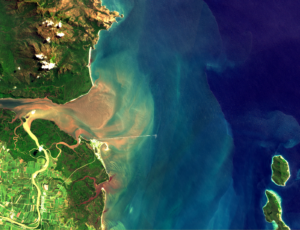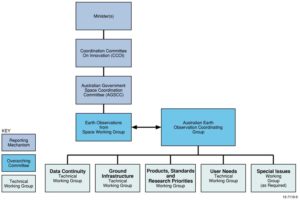Domestic Engagement

Sentinel 2 image of Lucinda in North Queensland. At the end of the 5km long jetty in the centre is the Lucinda Jetty Coastal Observatory used for validation activities
CSIRO Communities of Practice
The Centre for Earth Observation coordinates several internal Communities of Practice for Earth Observation (EO) practitioners. These groups aim to connect all active users of specific EO technology for EO within CSIRO, and enable discussion and collaboration to support research. A workshop bringing the community together over a few days is held at least every year, and presents researchers with an opportunity to engage with external stakeholders.
Current Communities of Practice include:
- SAR: Synthetic Aperture Radar is s a side-looking imaging radar process that transmits a series of short, coherent pulses to the ground and then measures the strength and phase of the signals scattered back to the instrument, providing all-weather, day/night imaging capability.
- LiDAR: Light Detection and Ranging uses illuminates imaging targets using light in the form of a pulsed laser to measure variable distances to Earth, generating precise, three-dimensional information about the shape of Earth and its surface characteristics.
- Hyperspectral: analyses the spectral properties of varying electromagnetic radiation from different targets on Earth’s surface based on analysis of the emitted and reflected radiation detected by a high number of narrow, contiguous and continuous spectral bands.
CSIRO Earth Observation Symposium
The annual Earth Observation (EO) Symposium brings together all internal practitioners of and researchers with an interest in EO. The aim of the event is to foster collaboration and connections across different Business Units within the organisation.
Australian Government Earth Observations from Space Working Group
The Australian Government Earth Observations from Space Working Group (the Group) brings together Australian Government agencies to coordinate civilian activities relating to the exploitation of Earth Observation (EO) satellites in support of Australian Government priorities. The Group is co-chaired by the Bureau of Meteorology, Geoscience Australia and CSIRO, as the agencies that develop and maintain the Commonwealth’s civilian EO from space infrastructure. The Group also engages with agencies relying on EO satellites and related services, and more broadly with state and territory governments, industry representative bodies and national research infrastructure facilities.

Australian Government EO governance structure, from ‘National Earth Observation from Space Infrastructure Plan’, produced by GA/BOM 2013
Key activities of Australian Government agencies in relation to EO from space infrastructure coordinated through the Group are:
- Participating in national coordination and collaboration in relation to Australia’s EO from space infrastructure.
- Establishing partnerships with EO from space satellite operating space agencies, and securing access to data for Australia.
- Maintaining and operating satellite ground stations to support downlink and provide command and control support for key bi-lateral partners.
- Acquiring, curating and distributing nationally significant EO satellite datasets and derived products.
- Installing and operating instrumented calibration/validation facilities.
- Lowering technical barriers to the use of EO satellite datasets.
- Representing Australia’s interests in key multi-lateral fora relating to EO from space.
Australian Coordination Office for international engagements (GEO/CEOS)
Australia is a major user of EO, and investment in EO-related capabilities is increasing, both in government, in the research community, and in the private sector. The Australian Government aims for local industry to participate in the global satellite applications market, exploiting EO alongside other technologies. Australia also advocates for EO to be applied internationally to improve governance and to support sustainable economic development.
Australia’s representation in both key international fora is a ‘team effort’ – CSIRO is lead for Australia in CEOS; GA is lead for Australia in GEO (see International Engagement). The functions of a national GEO/CEOS office will include:
- Supporting Australia’s participation in GEO and CEOS leadership & governance.
- Engaging the Australian EO community in GEO/CEOS.
- Fostering GEO’s objectives generally through advocacy of EO and the work of GEO.
- Developing, and monitoring implementation of, a plan for Australia’s National EOSS.
- Assisting Australian Government agencies to promote their domestic and international goals through CEOS, GEO and other fora.
- Advising relevant parts of government on EO investment priorities.
